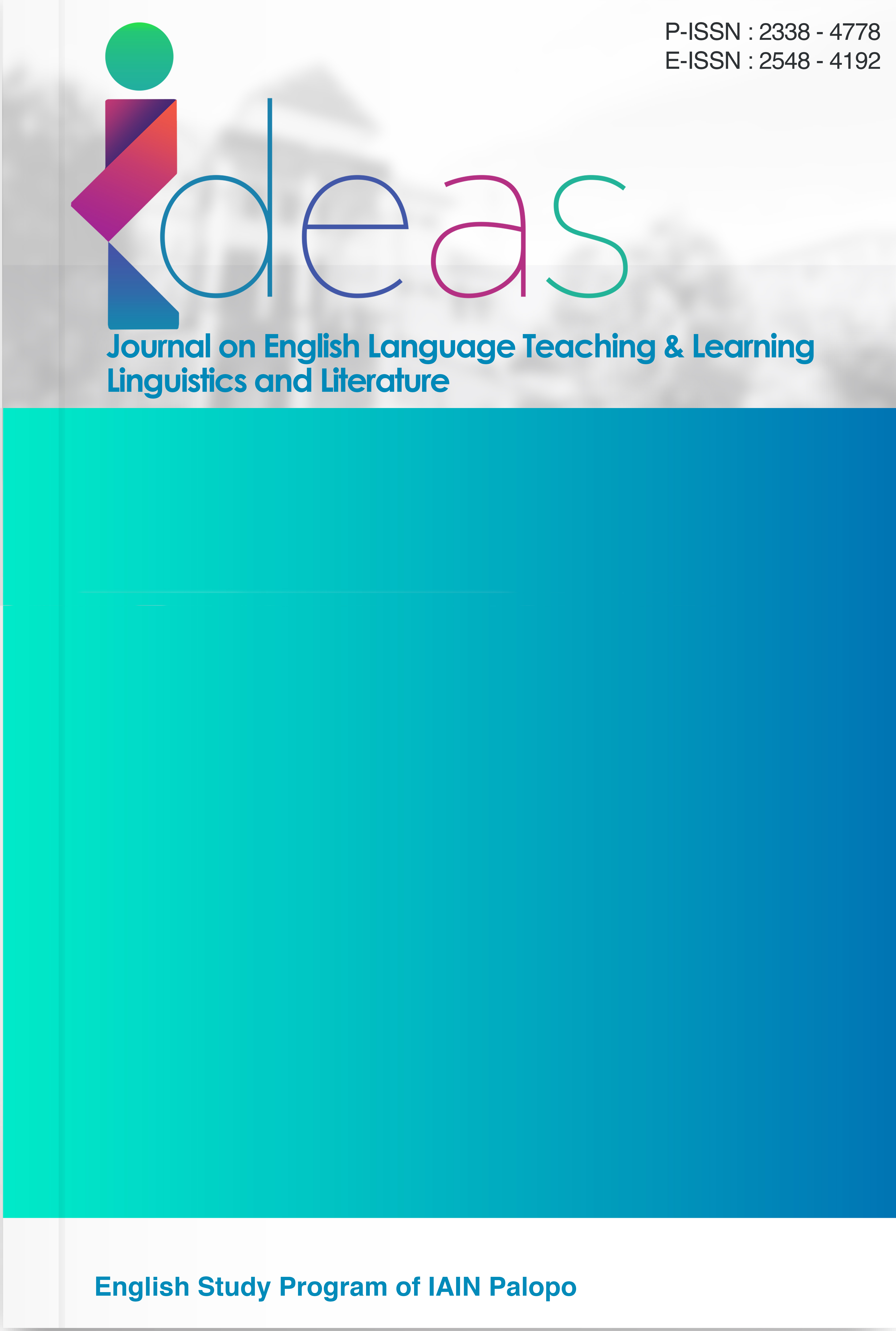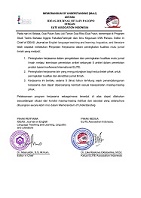Exploring The Implementation Process of an ESP Program for Engineering Students: A CIPP-Based Evaluation
DOI:
https://doi.org/10.24256/ideas.v13i2.6994Keywords:
CIPP Evaluation Model, English for Specific Purposes, Engineering EducationAbstract
This study evaluates the implementation of an English for Specific Purposes (ESP) program for engineering students at a private university in West Java, Indonesia, using the Context, Input, Process, and Product (CIPP) evaluation model. The study involved 15 participants, including 10 Mechanical Engineering students, 3 ESP instructors, and 2 program administrators. Employing a qualitative case study approach, data were collected through semi-structured interviews, classroom observations, and document analysis over a four-month period. The findings revealed that the program successfully identified students' professional language needs, particularly in technical writing and oral presentation, aligning well with industry and academic expectations. Quantitative data indicated an average 18% improvement in students' writing and presentation scores over one semester. Despite these gains, listening skills remained underdeveloped due to the limited integration of audio-based materials and listening-focused instruction. The curriculum applied project-based learning and included some authentic materials but was hindered by insufficient instructor training and inadequate resource support. The study underscores the importance of aligning curriculum design, pedagogical strategies, and resource allocation with learner needs. It also affirms the utility of the CIPP model in evaluating ESP programs holistically and provides practical implications for curriculum developers, language educators, and institutional policymakers committed to enhancing the quality and impact of ESP instruction in engineering education.
References
Al-Jardani, K. S. (2017). Evaluating the effectiveness of an ESP program: A CIPP model approach. International Journal of Applied Linguistics & English Literature, 6(6), 1-9. https://doi.org/10.7575/aiac.ijalel.v.6n.6p.1
Al-Mahrooqi, R., & Denman, C. J. (2020). Evaluating English for Specific Purposes (ESP) programs: A review of recent literature. Language Teaching Research Quarterly, 23(2), 150-168. https://doi.org/10.1177/1362168819876543
Anthony, L. (2018). The role of ESP in engineering education: Enhancing employability and academic success. Journal of English for Academic Purposes, 35, 12-22. https://doi.org/10.1016/j.jeap.2018.07.001
Basturkmen, H. (2010). Developing Courses in English for Specific Purposes. Palgrave Macmillan.
Baxter, P., & Jack, S. (2008). Qualitative case study methodology: Study design and implementation for novice researchers. The Qualitative Report, 13(4), 544-559.
Berger, R. (2015). Now I see it, now I don’t: Researcher’s position and reflexivity in qualitative research. Qualitative Research, 15(2), 219-234. https://doi.org/10.1177/1468794112468475
Braun, V., & Clarke, V. (2006). Using thematic analysis in psychology. Qualitative Research in Psychology, 3(2), 77-101. https://doi.org/10.1191/1478088706qp063oa
Castleberry, A., & Nolen, A. (2018). Thematic analysis of qualitative research data: Is it as easy as it sounds? Currents in Pharmacy Teaching and Learning, 10(6), 807-815. https://doi.org/10.1016/j.cptl.2018.03.019
Chen, Y. (2019). Using the CIPP evaluation model to assess a university English language program. System, 81, 1-12. https://doi.org/10.1016/j.system.2019.02.003
Creswell, J. W., & Poth, C. N. (2018). Qualitative Inquiry and Research Design: Choosing Among Five Approaches (4th ed.). Sage Publications.
Denzin, N. K. (1978). The Research Act: A Theoretical Introduction to Sociological Methods (2nd ed.). McGraw-Hill.
Dudley-Evans, T., & St John, M. J. (1998). Developments in English for Specific Purposes: A Multi-Disciplinary Approach (Cambridge Applied Linguistics). Cambridge University Press.
Dudley-Evans, T., & St John, M. J. (1998). Developments in English for Specific Purposes: A Multi-Disciplinary Approach. Cambridge University Press.
Evans, S. (2013). Designing tasks for the business English classroom. ELT Journal, 67(3), 281–293. https://doi.org/10.1093/elt/cct021
Fusch, P. I., & Ness, L. R. (2015). Are we there yet? Data saturation in qualitative research. The Qualitative Report, 20(9), 1408-1416.
Hutchinson, T., & Waters, A. (1987). English for Specific Purposes: A Learning-Centred Approach. Cambridge University Press.
Hyland, K. (2018). English for Specific Purposes. Routledge.
Kassim, H., & Ali, F. (2010). English communicative events and skills needed at the workplace: Feedback from the industry. English for Specific Purposes, 29(3), 168–182. https://doi.org/10.1016/j.esp.2009.10.002
Kaur, J., & Khan, M. S. (2020). Evaluating ESP curriculum for engineering students: Challenges and opportunities. ESP Today, 8(1), 45-62. https://doi.org/10.18485/esptoday.2020.8.1.4
Lincoln, Y. S., & Guba, E. G. (1985). Naturalistic Inquiry. Sage Publications.
Paltridge, B., & Starfield, S. (2020). The Handbook of English for Specific Purposes (2nd ed.). Wiley-Blackwell.
Rahman, M. M. (2015). English for Specific Purposes (ESP): A Holistic Review. Universal Journal of Educational Research, 3(1), 24–31. https://doi.org/10.13189/ujer.2015.030104
Rahman, M. M., & Singh, A. (2022). Technology integration in ESP for engineering students: A task-based approach. Computer Assisted Language Learning, 35(3), 345-367. https://doi.org/10.1080/09588221.2021.1967890
Shenton, A. K. (2004). Strategies for ensuring trustworthiness in qualitative research projects. Education for Information, 22(2), 63-75. https://doi.org/10.3233/EFI-2004-22201
Stake, R. E. (1995). The Art of Case Study Research. Sage Publications.
Stufflebeam, D. L. (2003). The CIPP model for evaluation. In T. Kellaghan & D. L. Stufflebeam (Eds.), International Handbook of Educational Evaluation (pp. 31-62). Springer.
Stufflebeam, D. L. (2003). The CIPP model for evaluation. In T. Kellaghan & D. L. Stufflebeam (Eds.), International Handbook of Educational Evaluation (pp. 31-62). Springer.
Stufflebeam, D. L., & Shinkfield, A. J. (2007). Evaluation Theory, Models, and Applications. Jossey-Bass.
Yin, R. K. (2018). Case Study Research and Applications: Design and Methods (6th ed.). Sage Publications.
Downloads
Published
Issue
Section
Citation Check
License
Copyright (c) 2025 Mimin Aminah, Muchlas Suseno, Samsi Setiadi

This work is licensed under a Creative Commons Attribution-ShareAlike 4.0 International License.
Authors retain copyright and grant the journal right of first publication with the work simultaneously licensed under an Attribution-ShareAlike 4.0 International (CC BY-SA 4.0) that allows others to share the work with an acknowledgement of the work's authorship and initial publication in this journal.
Authors are able to enter into separate, additional contractual arrangements for the non-exclusive distribution of the journal's published version of the work (e.g., post it to an institutional repository or publish it in a book), with an acknowledgement of its initial publication in this journal.
Authors are permitted and encouraged to post their work online (e.g., in institutional repositories or on their website) prior to and during the submission process, as it can lead to productive exchanges, as well as earlier and greater citation of published work (See the Effect of Open Access)




